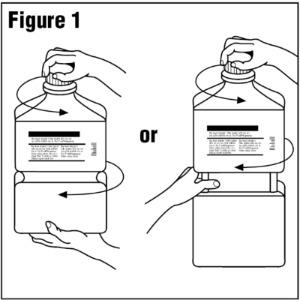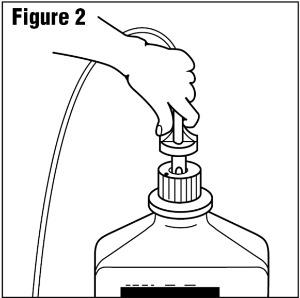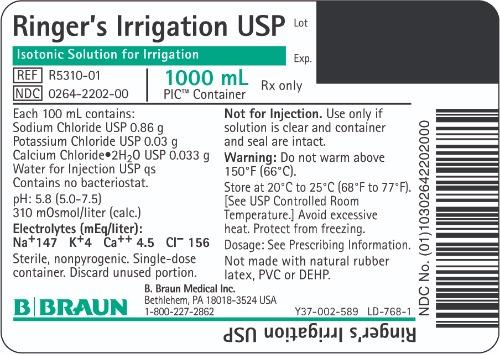Ringers Prescribing Information
Package insert / product label
Generic name: potassium chloride, calcium chloride and sodium chloride
Dosage form: irrigant solution
Drug class: Sterile irrigating solutions
Medically reviewed by Drugs.com. Last updated on Sep 6, 2023.
On This Page
Package Insert
PIC™ (Plastic Irrigation Containers)
Ringer’s Irrigation USP
FOR ALL GENERAL IRRIGATION, WASHING AND RINSING PURPOSES
Not For Injection By Usual Parenteral Routes
Semi-rigid Irrigation Container
Rx only
Ringers Description
Ringer’s Irrigation USP is a sterile, nonpyrogenic, solution of electrolytes in water for injection intended only for sterile irrigation, washing and rinsing purposes.
Each 100 mL contains:
Sodium Chloride USP 0.86 g; Potassium Chloride USP 0.03 g
Calcium Chloride Dihydrate USP 0.033 g; Water for Injection USP qs
pH: 5.8 (5.0-7.5). The solution is isotonic (310 mOsmol/liter, calc.) and has the following electrolyte content (mEq/liter): Na+ 147; K+ 4 Ca++ 4.5; Cl− 156
The solution contains no bacteriostat, antimicrobial agent or added buffer and is intended only for use as a single-dose or short procedure irrigation. When smaller volumes are required the unused portion should be discarded. Ringer’s Irrigation USP may be classified as a sterile irrigant, wash, rinse and pharmaceutical vehicle.
The formulas of the active ingredients are:
| Ingredients | Molecular Formula | Molecular Weight |
|---|---|---|
| Sodium Chloride USP | NaCl | 58.44 |
| Potassium Chloride USP | KCl | 74.55 |
| Calcium Chloride Dihydrate USP | CaCl2•2H2O | 147.01 |
The plastic container is a copolymer of ethylene and propylene formulated and developed for parenteral drugs. The copolymer contains no plasticizers and exhibits virtually no leachability. The plastic container is also virtually impermeable to vapor transmission and therefore, requires no overwrap to maintain the proper drug concentration. The safety of the plastic container has been confirmed by biological evaluation procedures. The material passes Class Vl testing as specified in the U.S. Pharmacopeia for Biological Tests — Plastic Containers. These tests have shown that the container is nontoxic and biologically inert.
Not made with natural rubber latex, PVC or DEHP.
Ringers - Clinical Pharmacology
Ringer’s Irrigation USP exerts a mechanical cleansing action for sterile irrigation of body cavities, tissues or wounds, indwelling urethral catheters and surgical drainage tubes, and for washing, rinsing or soaking surgical dressings, instruments and laboratory specimens. It also serves as a vehicle for drugs used for irrigation or other pharmaceutical preparations.
Ringer’s Irrigation USP provides an isotonic irrigation with the same ionic constituents as Ringer’s Injection USP, a modification of Ringer’s solution (also called Ringer’s mixture) originally used only as a topical physiologic salt solution.
Ringer’s Irrigation USP is considered generally compatible with living tissues and organs. Calcium Chloride in water dissociates to provide calcium (Ca++) and chloride (Cl−) ions. They are normal constituents of the body fluids and are dependent on various physiologic mechanisms for maintenance of balance between intake and output. Approximately 80% of body calcium is excreted in the feces as insoluble salts; urinary excretion accounts for the remaining 20%.
Potassium chloride in water dissociates to provide potassium (K+) and chloride (Cl−) ions. Potassium is the chief cation of body cells (160 mEq/liter of intracellular water). It is found in low concentration in plasma and extracellular fluids (3.5 to 5.0 mEq/liter in a healthy adult). Potassium plays an important role in electrolyte balance.
Normally about 80 to 90% of the potassium intake is excreted in the urine; the remainder in the stools and to a small extent, in the perspiration. The kidney does not conserve potassium well so that during fasting or in patients on a potassium free diet, potassium loss from the body continues resulting in potassium depletion.
Sodium chloride in water dissociates to provide sodium (Na+) and chloride (Cl−) ions. Sodium (Na+) is the principal cation of the extracellular fluid and plays a large part in the therapy of fluid and electrolyte disturbances. Chloride (Cl−) has an integral role in buffering action when oxygen and carbon dioxide exchange occurs in the red blood cells. The distribution and excretion of sodium (Na+) and chloride (Cl−) are largely under the control of the kidney which maintains a balance between intake and output.
Water is an essential constituent of all body tissues and accounts for approximately 70% of total body weight. Average normal adult daily requirement ranges from two to three liters (1.0 to 1.5 liters each for insensible water loss by perspiration and urine production).
Water balance is maintained by various regulatory mechanisms. Water distribution depends primarily on the concentration of electrolytes in the body compartments and sodium (Na+) plays a major role in maintaining physiologic equilibrium.
Indications and Usage for Ringers
Ringer’s Irrigation USP is indicated for all general irrigation, washing and rinsing purposes which permit use of a sterile, nonpyrogenic electrolyte solution.
Contraindications
NOT FOR INJECTION BY USUAL PARENTERAL ROUTES.
An electrolyte solution should not be used for irrigation during electrosurgical procedures.
Warnings
FOR IRRIGATION ONLY. NOT FOR INJECTION.
Irrigating fluids have been demonstrated to enter the systemic circulation in relatively large volumes; thus this irrigation must be regarded as a systemic drug. Absorption of large amounts can cause fluid and/or solute overloading resulting in dilution of serum electrolyte concentrations, overhydration, congested states or pulmonary edema.
The risk of dilutional states is inversely proportional to the electrolyte concentrations of administered parenteral solutions. The risk of solute overload causing congested states with peripheral and pulmonary edema is directly proportional to the electrolyte concentrations of such solutions.
Do not warm above 150°F (66°C).
After opening container, its contents should be used promptly to minimize the possibility of bacterial growth or pyrogen formation.
Discard unused portion of irrigating solution since it contains no preservatives.
Precautions
General
Do not use for irrigation that may result in absorption into the blood.
Caution should be observed when the solution is used for continuous irrigation or allowed to “dwell” inside body cavities because of possible absorption into the blood stream and the production of circulatory overload.
Aseptic technique is essential with the use of sterile solutions for irrigation of body cavities, wounds and urethral catheters or for wetting dressings that come in contact with body tissues.
When used as a “pour” irrigation, no part of the contents should be allowed to contact the surface below the outer protected thread area of the semi-rigid wide mouth container. When used for irrigation via irrigation equipment, the administration set should be attached promptly. Unused portions should be discarded and a fresh container of appropriate size used for the start-up of each cycle or repeat procedure. For repeated irrigations of urethral catheters, a separate container should be used for each patient.
Use only if solution is clear and container and seal are intact. Discard unused portion.
Drug Interactions
Additives may be incompatible. Consult with pharmacist, if available. When introducing additives, use aseptic technique, mix thoroughly and do not store.
Carcinogenesis, Mutagenesis, Impairment of Fertility
Studies with Ringer’s Irrigation USP have not been performed to evaluate carcinogenic potential, mutagenic potential, or effects on fertility.
Pregnancy
Teratogenic Effects
Animal reproduction studies have not been conducted with Ringer’s Irrigation USP. It is also not known whether Ringer’s Irrigation USP can cause fetal harm when administered to a pregnant woman or can affect reproduction capacity. Ringer’s Irrigation USP should be given to a pregnant woman only if clearly needed.
Nursing Mothers
Caution should be exercised when Ringer’s Irrigation USP is administered to a nursing woman.
Geriatric Use
Clinical studies of Ringer’s Irrigation have not been performed to determine whether patients over 65 years respond differently from younger subjects. Other reported clinical experience has not identified differences in responses between elderly and younger patients. In general, dose selection for an elderly patient should be cautious, reflecting the greater frequency of decreased hepatic, renal, or cardiac function, and of concomitant disease or other drug therapy.
This drug is known to be substantially excreted by the kidney, and the risk of toxic reactions to this drug may be greater in patients with impaired renal function. Because elderly patients are more likely to have decreased renal function, care should be taken in dose selection, and it may be useful to monitor renal function.
Adverse Reactions/Side Effects
Possible adverse effects arising from the irrigation of body cavities, tissues, or indwelling catheters and tubes are usually avoidable when proper procedures are followed. Displaced catheters or drainage tubes can lead to irrigation or infiltration of unintended structures or cavities. Excessive volume or pressure during irrigation of closed cavities may cause undue distention or disruption of tissues. Accidental contamination from careless technique may transmit infection. Should any adverse reaction occur, discontinue the irrigant, evaluate the patient, institute appropriate therapeutic countermeasures and save the remainder of the fluid for examination if deemed necessary.
Overdosage
In the event of overhydration or solute overload, re-evaluate the patient and institute appropriate corrective measures. See WARNINGS, PRECAUTIONS, and ADVERSE REACTIONS.
Ringers Dosage and Administration
The dose is dependent upon the capacity or surface area of the structure to be irrigated and the nature of the procedure. When used as a vehicle for other drugs, the manufacturer’s recommendations should be followed.
Parenteral drug products should be inspected visually for particulate matter and discoloration prior to administration, whenever solution and container permits. See PRECAUTIONS.
How is Ringers supplied
Ringer’s Irrigation USP is supplied sterile and nonpyrogenic in PIC™ (Plastic Irrigation Containers). The 1000 mL containers are packaged 16 per case.
| NDC | Cat. No. | Size |
|---|---|---|
| Ringer’s Irrigation USP | ||
| 0264-2202-00 | R5310-01 | 1000 mL |
Exposure of pharmaceutical products to heat should be minimized. Avoid excessive heat. Protect from freezing. Store at 20°C to 25°C (68°F to 77°F); excursions permitted between 15°C to 30°C (59°F to 86°F). [See USP Controlled Room Temperature.] However, brief exposure up to 40°C does not adversely affect the product.
Do not warm above 150°F (66°C).
Directions for Use of PIC™ (Plastic Irrigation Container)
Not for injection.
Aseptic technique is required.
1. Caution – Before use, perform the following checks:
(a) Read the label. Ensure solution is the one ordered and is within the expiration date.
(b) Invert container and inspect the solution in good light for cloudiness, haze, or particulate matter; check the container for leakage or damage. Any container which is suspect should not be used.
Use only if solution is clear and container and seal are intact.
Single-dose container. Discard unused portion.
2. Outer Closure Removal – Grasp the container with one hand and turn the breakaway ring counterclockwise with the other hand until slight resistance is felt. Then, twisting the container in the opposite direction, turn the breakaway ring sharply until the entire outer cap is loose and can be lifted off. (Figure 1)

3. Connect the administration set through the sterile set port according to set instructions (Figure 2) or remove screw cap and pour.
4. Do not warm above 150°F (66°C) to assure minimal bottle distortion. Keep bottles upright.

PRINCIPAL DISPLAY PANEL - 1000 mL Bottle Label
Ringer’s Irrigation USP
Isotonic Solution for Irrigation
REF R5310-01
NDC 0264-2202-00
1000 mL
PIC™ Container
Rx only
Lot
Exp.
Each 100 mL contains:
Sodium Chloride USP 0.86 g
Potassium Chloride USP 0.03 g
Calcium Chloride•2H2O USP 0.033 g
Water for Injection USP qs
Contains no bacteriostat.
pH: 5.8 (5.0-7.5)
310 mOsmol/liter (calc.)
Electrolytes (mEq/liter):
Na+147 K+4 Ca++ 4.5 Cl– 156
Sterile, nonpyrogenic. Single-dose container. Discard unused portion.
Not for Injection. Use only if solution is clear and container and seal are intact.
Warning: Do not warm above 150°F (66°C).
Store at 20°C to 25°C (68°F to 77°F). [See USP Controlled Room Temperature.] Avoid excessive heat. Protect from freezing.
Dosage: See Prescribing Information.
Not made with natural rubber latex, PVC or DEHP.
B. Braun Medical Inc.
Bethlehem, PA 18018-3524 USA
1-800-227-2862
Y37-002-589 LD-768-1
Ringer’s Irrigation USP

| RINGERS
sodium chloride, potassium chloride, and calcium chloride irrigant |
||||||||||||||||||||
|
||||||||||||||||||||
|
||||||||||||||||||||
|
||||||||||||||||||||
|
||||||||||||||||||||
|
||||||||||||||||||||
| Labeler - B. Braun Medical Inc. (002397347) |
More about physiological irrigating solution topical
Professional resources
Other brands
Lactated Ringer's Irrigation, Cardioplegic, Physiolyte, Plegisol, Tis-U-Sol
